Selcouth Chronicles Week 15
Hello family and friends! Welcome to week 15 of the Selcouth Chronicles.
Week 15: April 14 - April 20
April 15 🚢 Split -> Dubrovnik
April 18 🛫 Dubrovnik -> 🛬 Athens
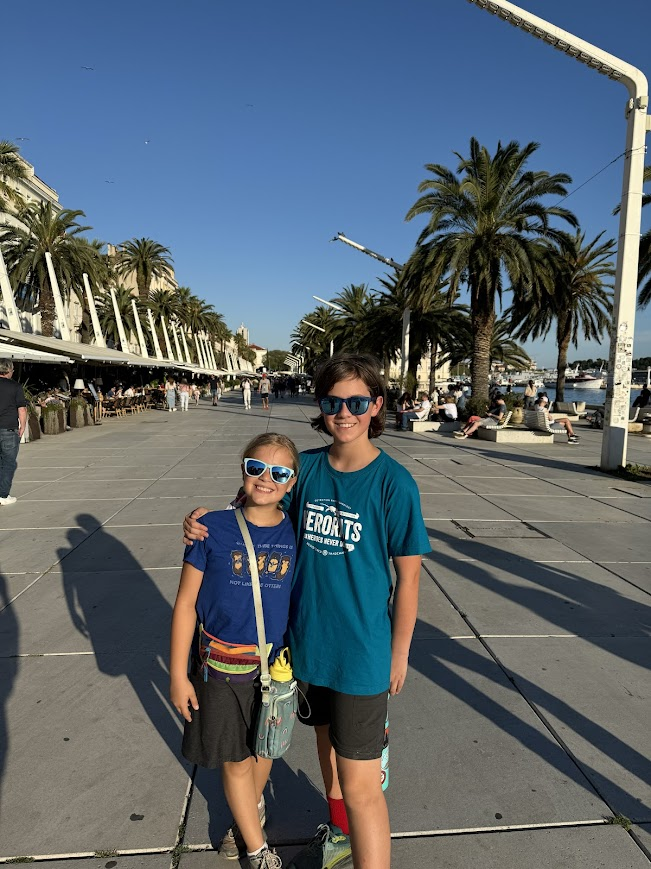
CROATIA AND GREECE
Highlights: Split Cathedral, ferry along Dalmatian Coast, throwing stones into the Adriatic Sea, walking Dubrovnik walls, gelato in the rain, Dubrovnik’s museums, meeting up with Meems and Papi in Athens, the many ancient ruins of Athens, Acropolis Museum
James:
Pozdrav svima i dobrodošli u još jedan tjedan Selcouth Chronicles! Prijeđimo odmah na naš sažetak:
(Hello everyone and welcome to another week of the Selcouth Chronicles! Let's jump right into our recap 😊)
Sunday started with the Museum of Fine Art in Split. I stayed home for that one - I didn’t want to see it and I was also a little sick. After everybody else came home, we went to climb the bell tower of Split Cathedral, a mass of stone, steel, and bronze that towers above the city. The only hitch was that the stairs at the start were ridiculously steep and very slippery, but modern stairs came after and we were able to climb normally. When we reached the top, all of Split was presented to us in a captivating panorama. When we came down, everybody agreed that that was one of the best views we’d seen in a little while. No breaks, though - we immediately set off to start climbing Marjan Hill. After a bit of hiking, we sat down on a bench with a great view of the harbor and had some Croatian history read to us by Mom. (Did you know that the country has been at war more than it has been at peace?) After dinner and chimney cones we headed back to the Airbnb after we were done to start packing for the next day.
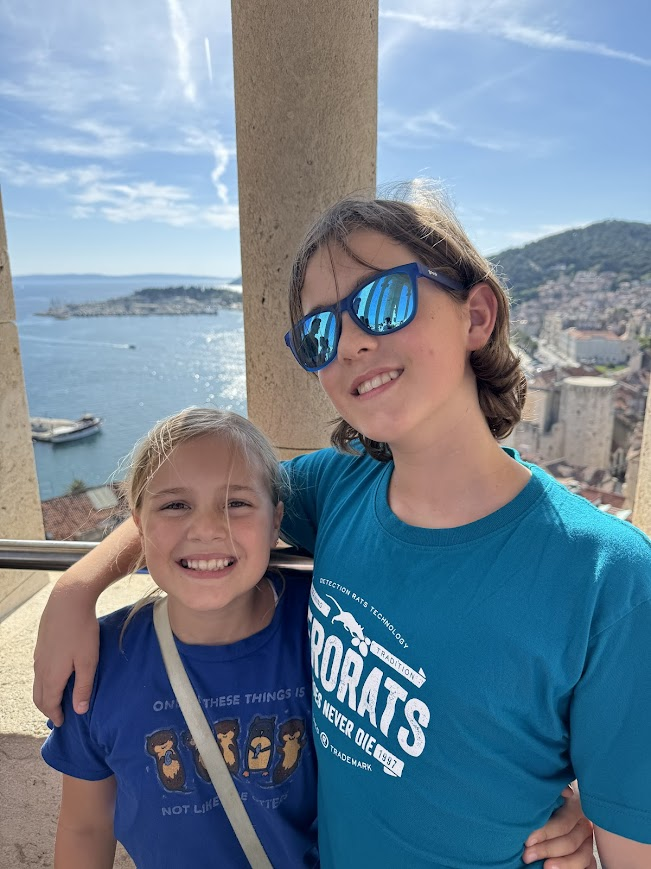
Monday began with Mom almost having to drag me out of bed to catch the very early 4-hour-long ferry to Dubrovnik. The scenery was wonderful, but I lost interest at about the 3-hour mark because I got tired of leaning past Abby to enjoy the view. When we arrived, we hopped into a car that drove us to the Buza Gate of Old Town Dubrovnik. Walking through its maze-like corridors was quite cool, but even though we arrived at the highest possible gate, we still had to walk up a lot of stairs with our heavy bags to reach our Airbnb. As a result, we were all slightly winded when we got to our apartment. After lunch, Dad went back to work while the rest of us went to explore the Old Town. We spent a while on a playground and a picturesque stone beach with very diverse rocks. When we were nice and sleepy, we marched back through town to the supermarket to pick up ingredients for dinner. Unfortunately for us, by then we were at the bottom of town and we had to climb a huge number of stairs to get back to our place. That happened every day in Dubrovnik! Abby then made dinner for everyone all by herself.
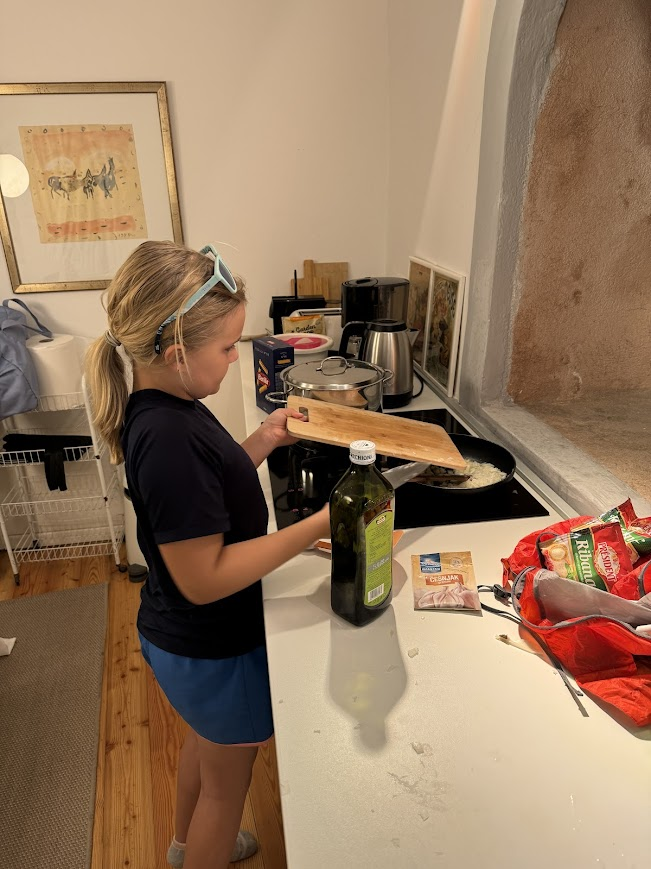
On Tuesday we had plans to walk the walls of Dubrovnik. Construction on the walls began in the 13th century to protect the city from invaders. It was a marvelous walk but very windy! In fact the gale was so strong that sometimes walking on stairs felt dangerous. The total distance walked was over a mile, so by the time we were finished we were hungry! We picked up a nice lunch at the Taj Mahal (a restaurant, not the building, haha) and then Dad went back to the apartment to work while the rest of us went to Rector’s Palace. The palace was a huge museum with quite a lot of inappropriate pictures - Renaissance art is weird! - but otherwise had a lot of cool artifacts, including trunks with extremely elaborate locks, sedan chairs, and centuries-old dressers. After the palace, we went and got gelato, but unfortunately it started to rain. We headed back to the Airbnb, glad the rain jackets we’d brought along all day hadn’t been for nothing.

Wednesday began with the Ethnographic Museum and Natural History Museum. Both were very entertaining and full of interesting facts about Dubrovnik. After, Dad and I headed to Rector’s Palace because Dad hadn’t seen it yet. Meanwhile, Mom and Abby went to Dulčić Masle Pulitika Gallery, a modern art gallery. After lunch, we went to the War Photo Limited gallery. WPL is a collection of photos taken during times of war, and some of it was a little scary. But overall, the gallery really touched you and we all came away with a heightened understanding of what it looks like to be at war.
Thursday morning began with packing. When it was done, we trekked over to the Love Stories Museum, a really sweet museum that documented relationships and how they began, and had donated objects from the story-giver. It was delightful! We even got to see love stories from movies and the origins of famous songs. The museum was made as a counterbalance to the Museum of Broken Relationships that we visited in Zagreb. Next on our list was the Cathedral of the Assumption of the Virgin Mary, a baroque-style church. It had a high domed ceiling and polished-wood pews. Lunch came soon after, and we ate burek - delicious stuffed pastry rolls. Following lunch was a trip back to our apartment to collect our bags, and catch an Uber to the airport. We flew to Athens to meet Meems and Papi, our grandparents. Abby and I had been counting down the days until we all met up. 🙂
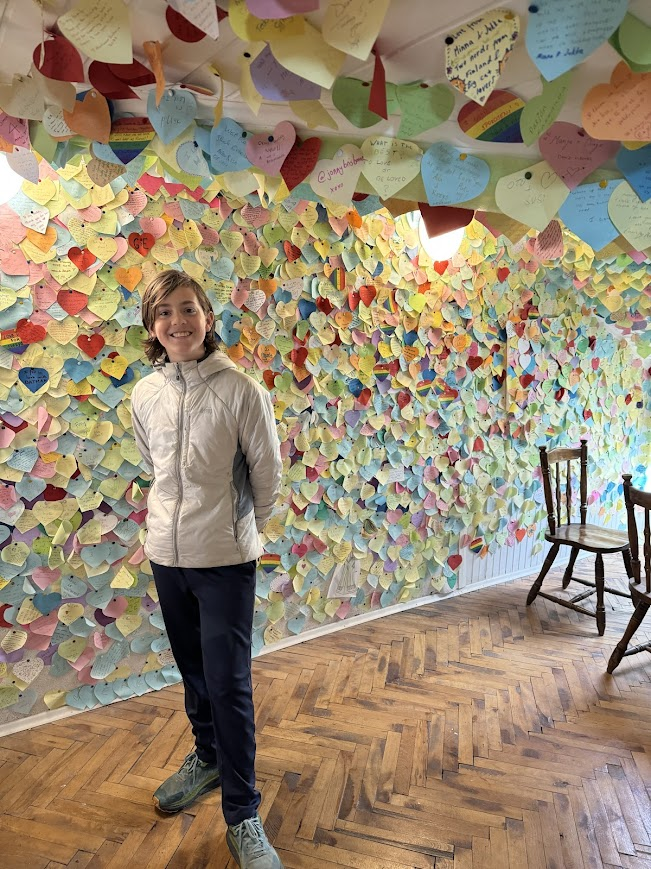
Friday we started our experience in Greece! This country was a place I’ve been wanting to visit for a long time because I’m really into Greek mythology and I’ve studied ancient Greece in Social Studies class. The first place that we visited was a history museum called the Benaki Museum, which teaches about Greek Culture. On the way to the museum, we saw the changing of the Presidential Guard. It was unlike any other guard I’ve seen; the soldiers had pom poms on their shoes with steel bottoms. They walked in such an exaggerated manner, lifting their legs as high as they could go and smacking the ground with their heels. I thought it was kind of hilarious to watch!
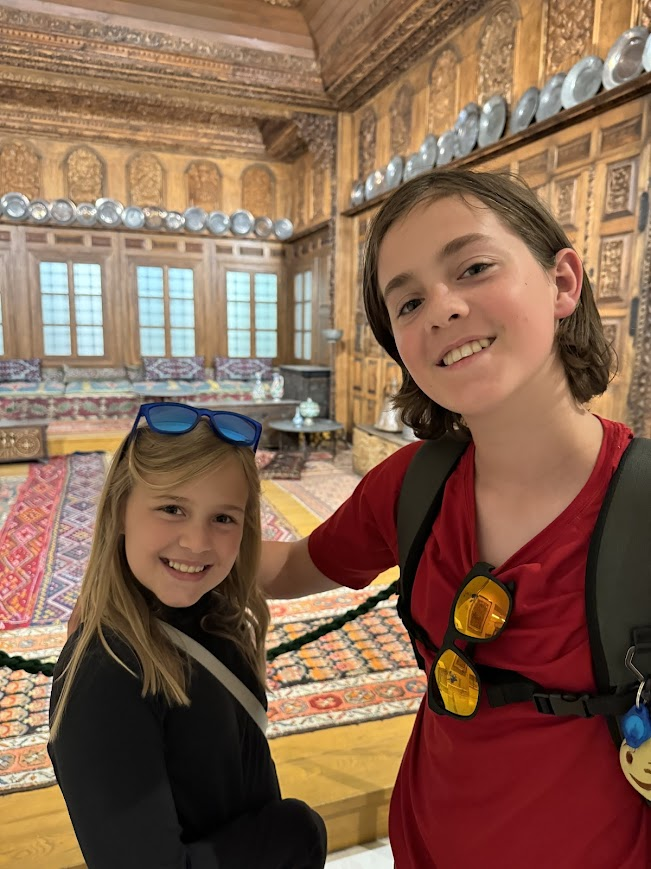
Once we finished off the museum, we had lunch and then wandered through a neighborhood called Plaka. It’s known as the “Neighborhood of the Gods,” because it is hugging the borders of the Acropolis. There are a lot of interesting shops, and we got some delicious gelato from one of the stores. Yum! I’d call that a successful day, but Saturday was even better.
Saturday was truly an on-your-feet sort of day. From the moment we got out the door, we had places to go. Our first destination was the ticket counter for the Acropolis Museum, where we bought 5pm tickets to avoid the worst of the tourist crowds. Then we went to see some ancient temples - and sometimes their ruins. We saw the Roman Agora, Hadrian’s Library, and Hephaestus’ Temple at the Ancient Agora. They were all impressive! Strong marble pillars rising high above the ground supporting centuries-old stone carvings. Walking among them was breathtaking. Luckily, the sky was cloudy and that prevented us from getting too warm.
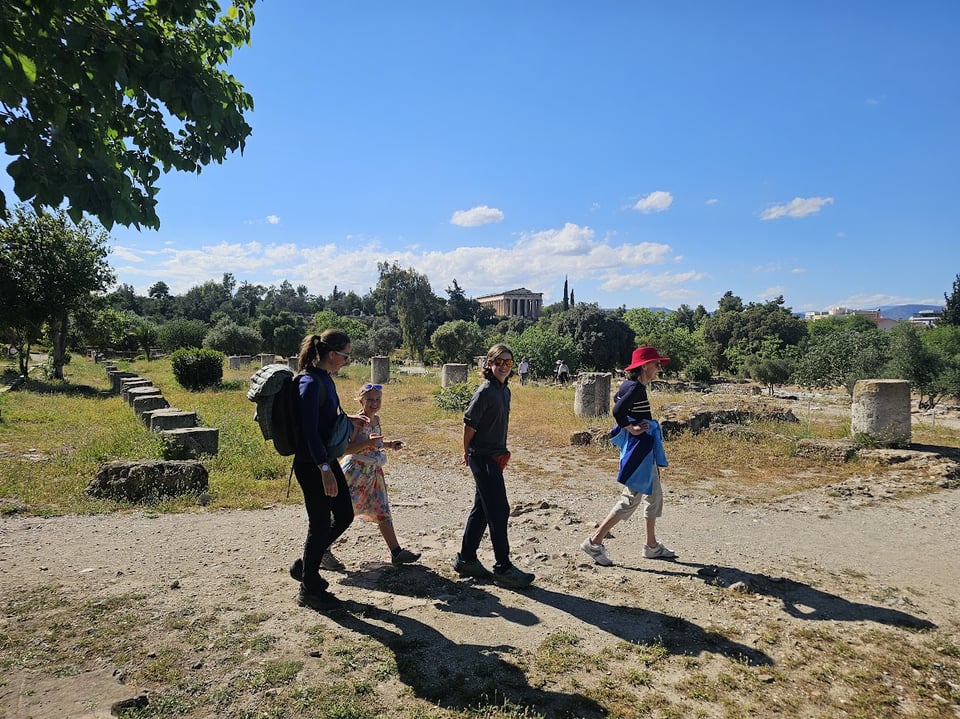
We wandered there for around a few hours until it was time to leave for the Acropolis Museum. Everyone was a little reluctant to go because we were enjoying our time at the ancient sites, but it turned out that the museum was just as much fun. When we arrived at the Acropolis Museum, there were so many stone carvings it was ridiculous. They filled the massive rooms. Some were in protective display cases, but most were not, allowing you to get up close and personal with the statues. Despite the fact that there were so many, they each had an individual backstory typed on information cards at their bases. Statues, wreckage, pieces of (really) old walls, it was all there. Three huge floors of it. By the time I was done, my brain was full and my legs were tired. It was a very history-oriented week for us!
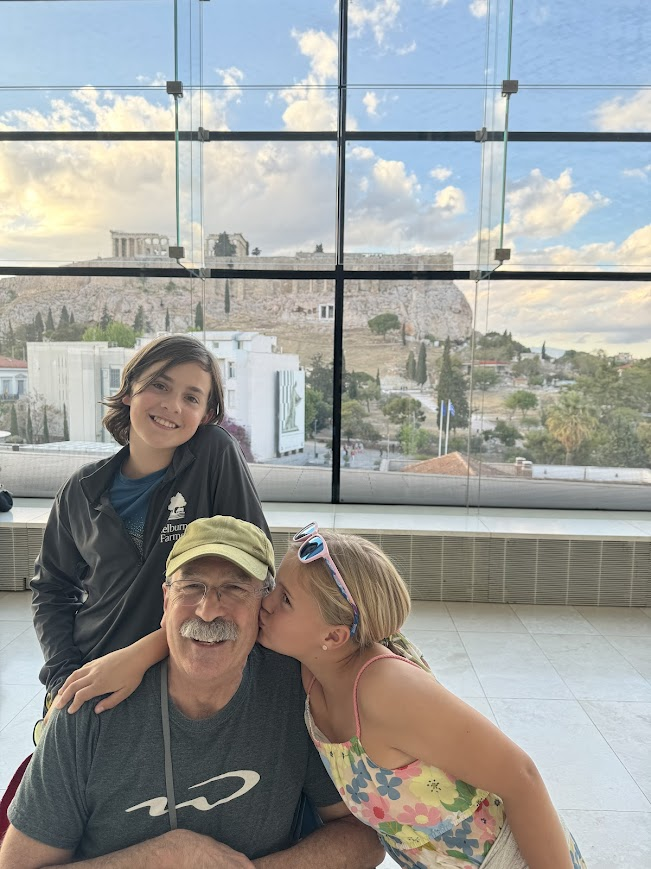
Caitlin:
Anyone who has been on a trip probably understands the desire to make the most of your time. When you have limited days in a new place, you want to make sure that you experience all the best that it has to offer. It’s a self-imposed pressure, to be sure, but present nonetheless.
But what does the best experience look like? That can be a tricky question to answer when you’re continuously on the go. It’s not uncommon for us to have only two or three full days in a particular town or city, and the compressed time doesn’t leave much room for days off. As I’ve mentioned in the newsletter before, we do try to make sure that our activities are a mix of educational and fun things. We don’t want to burn out. We want to allow time for kids to just do “kid things” and be silly. It’s good for all of us to take things slow some days and often these things even give us the opportunity to be with local people living their daily lives.
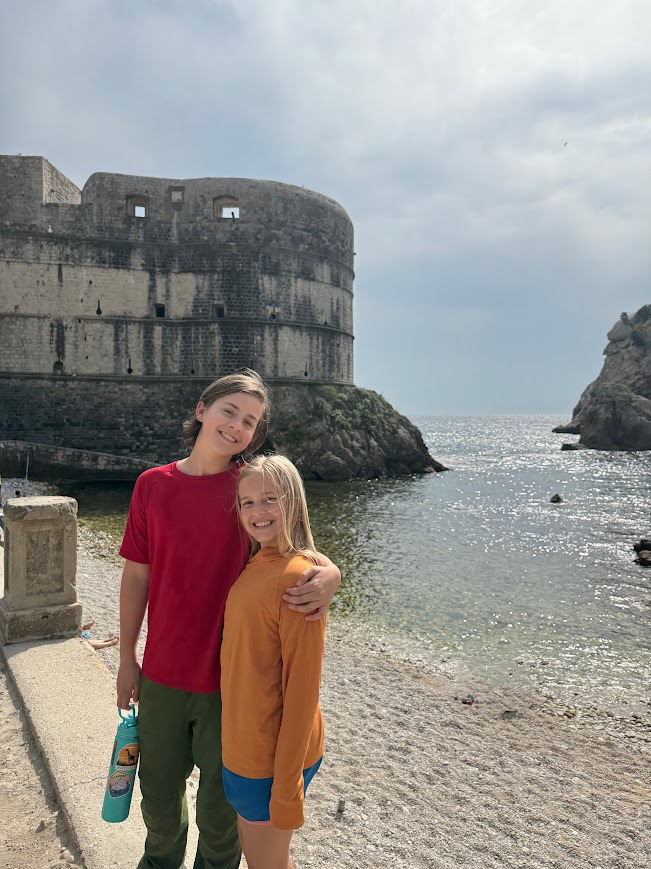
Lately we’ve had to think about a different kind of challenge to our time constraints, which is what to do if someone isn’t feeling their best. We’ve been very lucky that - apart from my miserable night of food poisoning in January - everyone has been physically healthy and up for new adventures. Our energy levels may vary from day to day, but we can always get through and enjoy whatever we have planned for that day.
Then one day recently Abby mentioned that she was feeling tired. I kissed her forehead and noticed that she was feeling unusually warm. At home we would have gone home to let her rest, but we were in the middle of a day with a (pre-paid) private guide showing us around Istanbul. Even if it had been possible to rebook, we were on the second of two full days in the city, so going back to the apartment would have meant missing most of the top sights on our must-see list. In the end, we decided to keep going. We kept things as relaxed as we could, gave Abby a bit of medicine and a mask, and finished out the day. Abby was glad that she got to see everything, but she was wiped out when we put her to bed early and I didn’t feel great about having to push her. Luckily, after a good night of sleep we were able to lay low at the apartment the next morning before departing for Croatia, and though she wore a mask for a few days she recovered quickly.
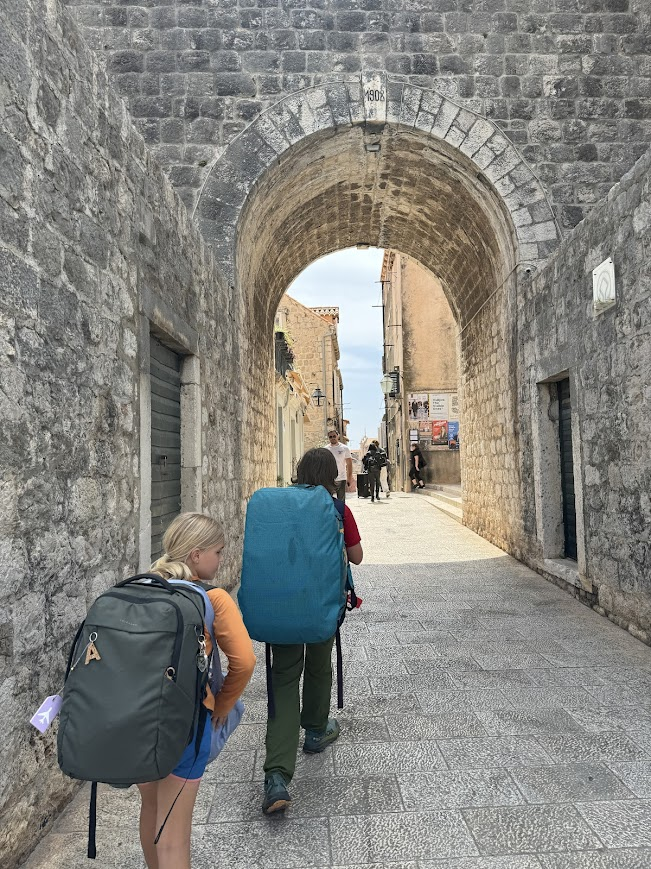
By the end of the next week we were in Split. It was a relatively long stop for us, so it was bad timing that the single day when we had booked a tour that would take us to the neighboring town of Trogir was when I noticed dark circles under James’ eyes and he told me he wanted to go back to sleep. Warm forehead again, but once more we finished out the day together, put the kids to bed early, and changed plans to have quiet time to recover the following day. I have to give the kids credit for getting through days when they weren’t feeling great, and luckily they were only mildly unwell. Still, it’s been a reminder that though we are in month four of our travels, we are still needing to adjust and recalibrate. We’re doing our best to make good choices for our family and ensure that it’s an enjoyable experience for everyone.
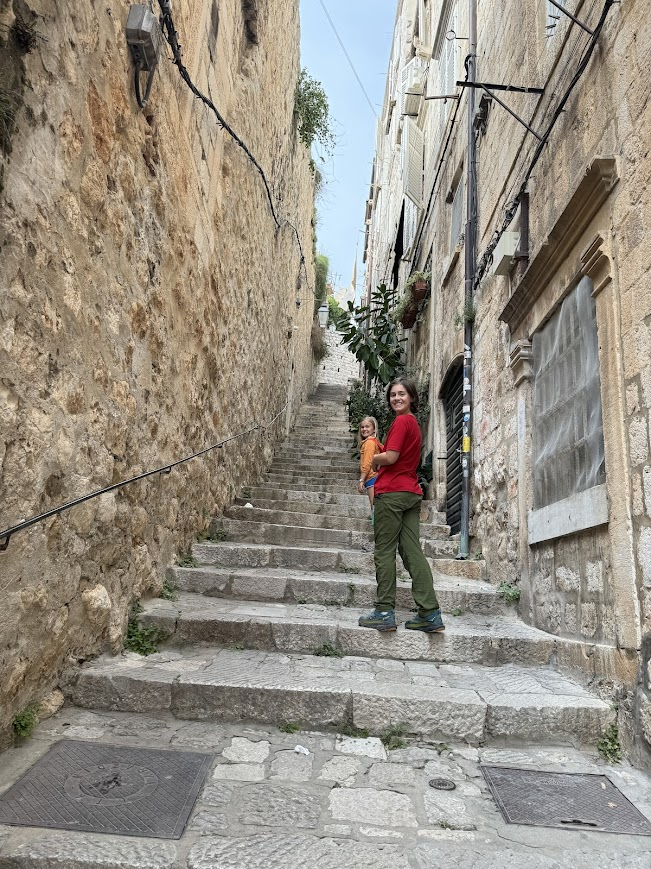
Abby:
We have been to a lot of war museums in the time that we have been traveling. It’s hard to see the pictures of people in so much pain and stress. Even though I don’t always like going to them, the museums teach me a lot and help me understand the effects of war.
One of the things that I think about a lot while walking around the museums is how lucky I am. I have such an amazing life. I live in an area that is very safe and stable. There are no wars near us or that are affecting me or my family directly. I’m very grateful that I have never had to experience war or anything like it.
In the museums, I often find myself being moved the most by objects and pictures of people. In Hiroshima, seeing the remains of burned lunchboxes, clothing, bikes, and more was very sad for me. It reminds me that these people were real people, living their lives. There was a story of a boy whose mother made him a special lunch for work, and he was excited to eat it. He never got to eat it. His burnt lunchbox is in the museum, and I almost cried looking at it.
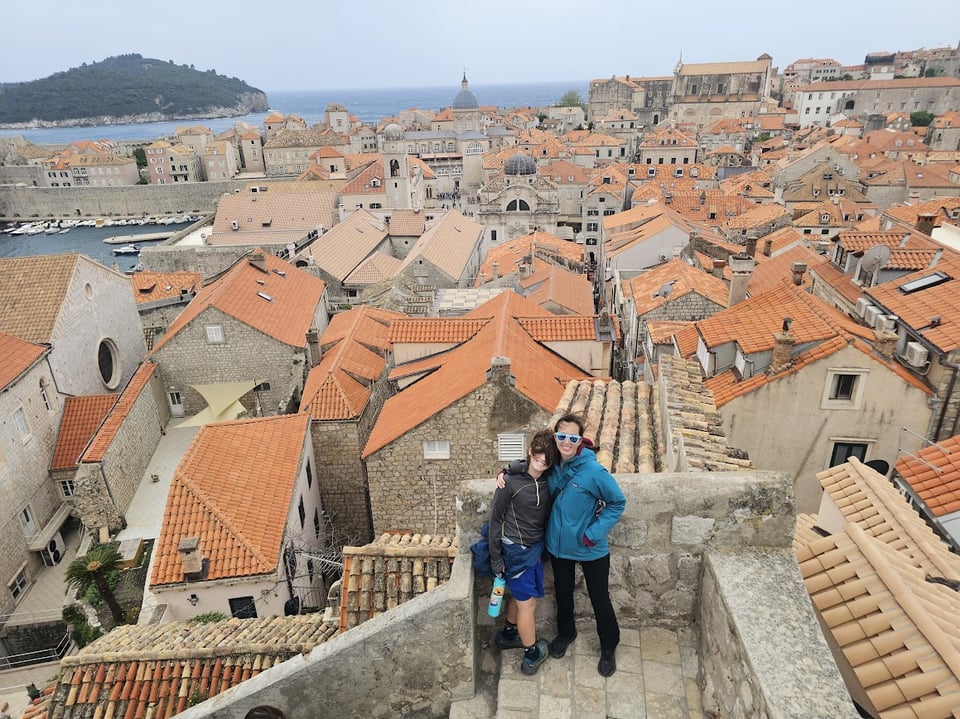
The Dubrovnik museum was all photos of war, with a focus on the Yugoslavian War. There were many pictures, but the ones that I found most moving were the pictures of people mourning over their dead loved ones. There was one of a kid at his father’s funeral. He was understandably crying very hard. I knew that that’s what I’d be doing if that happened, and it really hurt to see. There were other photos of (mostly) women finding out that their husbands had been killed fighting, and of course they were crying too. Other photos of different wars around the world showed many pictures of kids around my age with rifles on their shoulders. I can’t imagine being forced to fight in a war, let alone shooting a gun at someone.
The Dubrovnik Museum is not the last war museum we will see. It’s going to be just as hard to see the pictures next time too, but I will go because I think that everyone should see the harm that war causes people and be able to better appreciate the good in their own lives. War is a big part of a lot of places, and you can’t fully appreciate the value of the place you’re in without knowing what a city and its people have been through.
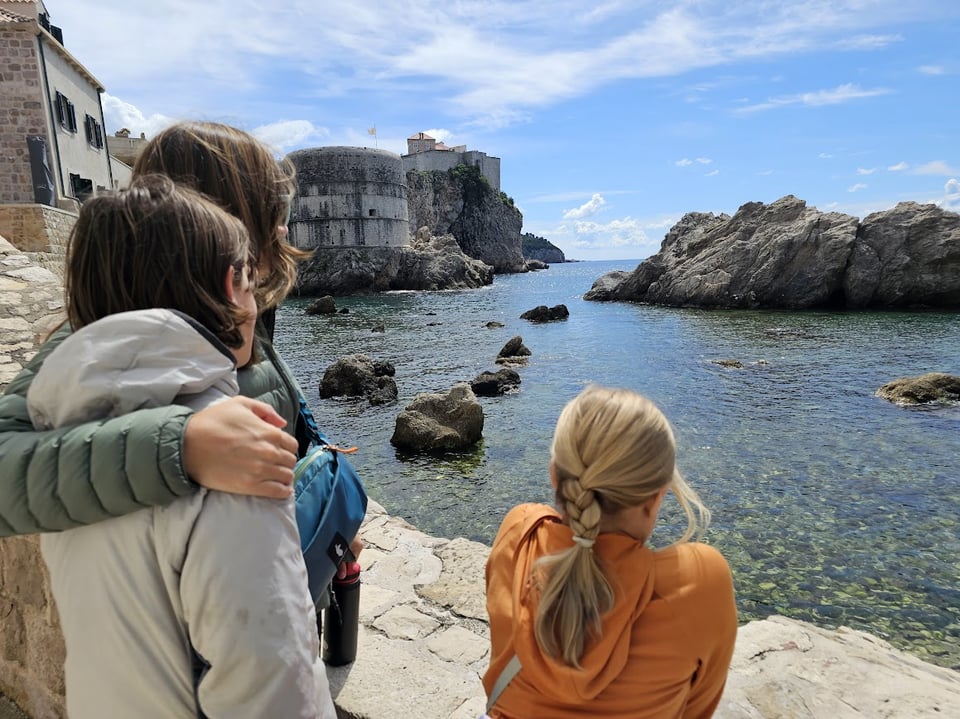
Sean:
Walking down the Stradun, the main thoroughfare in Dubrovnik, it’s fun to imagine people hundreds, sometimes thousands, of years in the past walking the same route. All of the towns we visited this week have been continuously inhabited for the majority of the common era, if not the entirety. Each carries with it its own fascinating history that can be seen and experienced. As we discussed with the kids while walking through Dubrovnik, “If only these walls could talk!”
I spent last week discussing Split, so won’t dive into it too much here. The fascinating experience of that town was seeing how it had transitioned from the retirement palace of a Roman emperor. As the inhabitants of Split grew from refugees and expansion, people took whatever space they could find to build a home. Since Roman roads were wide to allow easy transport, there was plenty of space to put homes there. This led to a complete maze of buildings spread out across the town, and today results in a labyrinth of tight corridors that open into squares with roads leading out in scattershot directions.
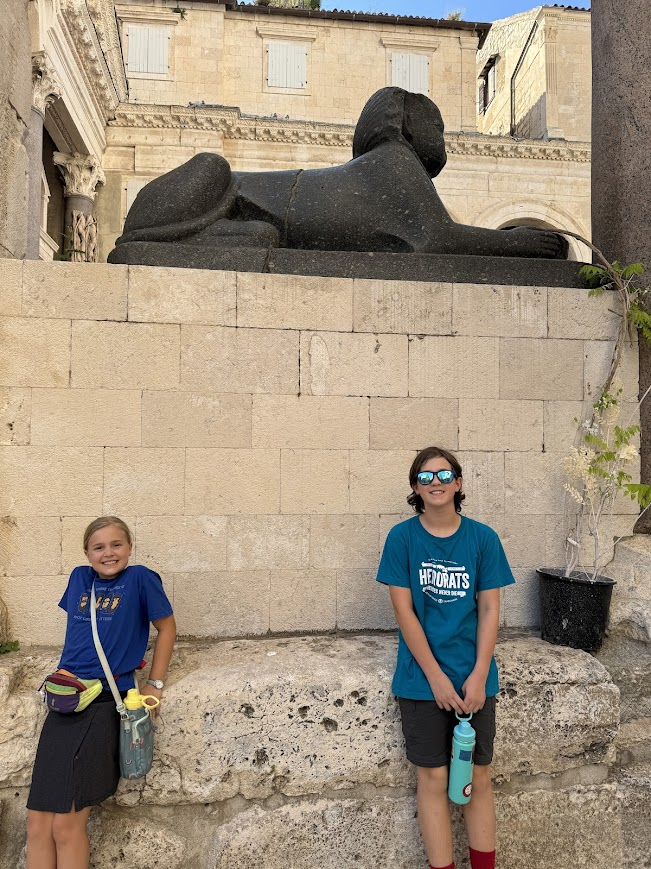
Dubrovnik’s journey was very different, as it has stood as a semi-autonomous city state for much of its history. This meant that though it participated in many historical events, it was able to weather them much better on its own. The result of the stability leads to a much more sensible grid pattern in the city. In my opinion, this is less entertaining, but much easier to manage as you wander. A big factor that kept the city safe were the walls that have surrounded the old town for perhaps a thousand years in some form. The forts and battlements of the wall are spectacular, and were a significant reason that Dubrovnik was used as the backdrop of King’s Landing as well as other sites in the Game of Thrones. Walking the walls is considered the must-do tourist activity in the city, and we can attest that the views of the sea and the city are incredible. In some places the walls rise up to 25 meters, giving an expansive view of the city and its surroundings. One striking detail is the different color of the roof tiles. This is due to the shelling that Dubrovnik weathered in 1991, when Croatia declared its independence from Yugoslavia. The city was surrounded and besieged by the army and was shelled by artillery. Many of the buildings suffered damage, particularly on their roofs. As the buildings were repaired, they used the same materials as the original, but as it is new and not as weathered, you can see a noticeable difference in colors. As time goes on, the visible reminder of the wars fades. During our time in Croatia, we heard from locals who would mention “the wars,” and it’s obvious the impact the conflicts had on the social fabric of the country.
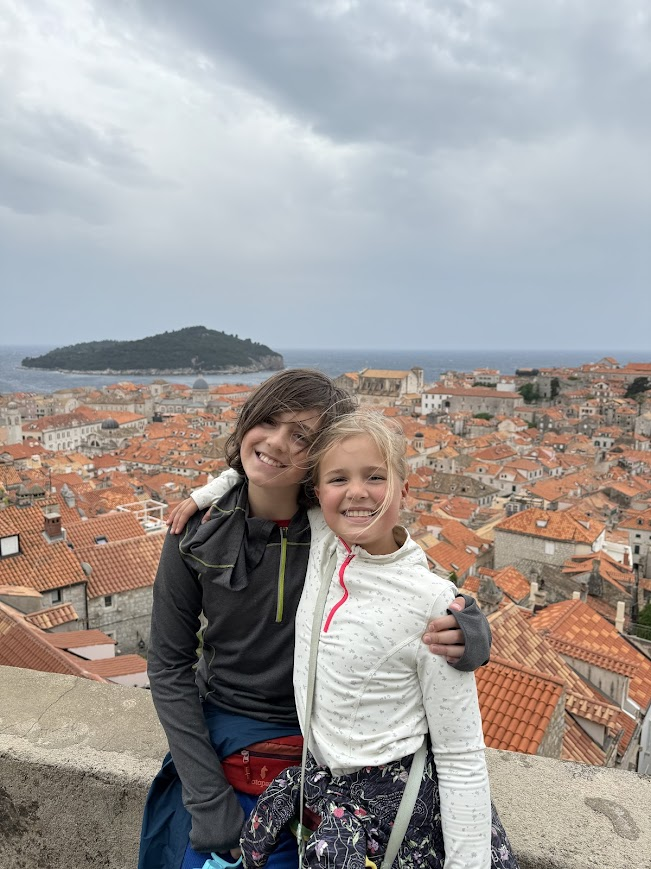
We end our week in Athens, where history may be the most present in the very make up of the city. Here you can see the collision of modern life with the preservation of ancient architecture. Rising above the city, the acropolis reminds you of the immense place this area holds in the history of the region. It seems you go from a busy street with heavy traffic, turn a corner, and you’re walking through columns of a 2000 year old entry to a temple. Many are for Athena, the city’s patron goddess and guardian. The story goes that at the founding of the city, Poseidon and Athena were vying for the city by bestowing gifts. Poseidon struck the ground with his trident and a spring gushed forth, but it was saltwater. Athena gifted the city an olive tree. The citizens chose the olive tree, and the city was therefore named for the god Athena. We’ll continue our adventures through Athens in the following days, and look forward to getting lost down thousand year old streets, wondering what families back then might have been doing in their day-to-day lives.
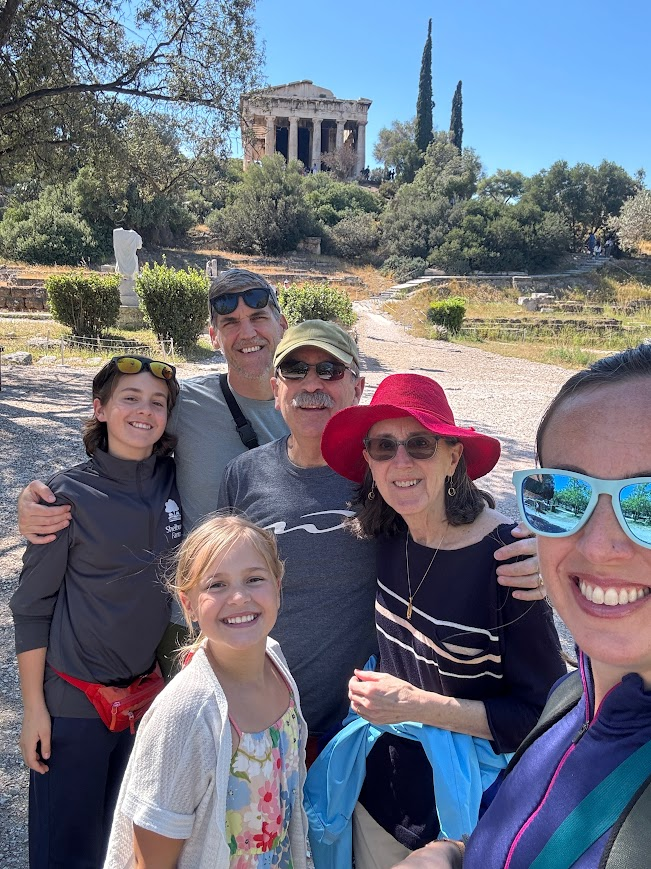
See you next week!
Sean, Caitlin, James, and Abby
Catching up? Read week 1, 2, 3, 4, 5, 6, 7, 8, 9, 10, 11, 12, 13, or 14.